Themed collection Materials, Physical and Biological Chemistry of Protein Cages

Tuning properties of biocatalysis using protein cage architectures
The properties of biocatalysis can be tuned by encapsulation of enzymes inside protein cages, which alters enzyme behaviors, substrate access and product release, and efficiency of cascade reactions.
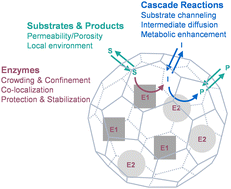
J. Mater. Chem. B, 2023,11, 3567-3578
https://doi.org/10.1039/D3TB00168G
Virus-like particles nanoreactors: from catalysis towards bio-applications
Virus-like particles (VLPs) are self-assembled supramolecular structures in nature for compartmentalization. We summarize the current progress of protein cage nanoreactors spanning multilength scales, and highlight the emerging field of VLP based nanoreactors for biomedical applications.

J. Mater. Chem. B, 2023,11, 9084-9098
https://doi.org/10.1039/D3TB01112G
Structural polymorphism in protein cages and virus-like particles
There are many native and engineered capsid-forming proteins which can self-assemble into different non-canonical structures. In this review, we categorise examples of structural polymorphism by their method of formation.

J. Mater. Chem. B, 2023,11, 6516-6526
https://doi.org/10.1039/D3TB00991B
Innate and engineered attributes of bacterial microcompartments for applications in bio-materials science
All protein prokaryotic organelle in bio-material science applications.

J. Mater. Chem. B, 2023,11, 4842-4854
https://doi.org/10.1039/D3TB00098B
Encapsulin cargo loading: progress and potential
Encapsulins are protein compartments that encapsulate cargo proteins via specific peptide targeting motifs. Fusion of these motifs to non-native cargo proteins allows the facile engineering of rationally designed nano-compartmentalization systems.

J. Mater. Chem. B, 2023,11, 4377-4388
https://doi.org/10.1039/D3TB00288H
Ferritin nanocages: a versatile platform for nanozyme design
Overview of ferritin nanocage and ferritin nanozyme. The ferritin nanocages hold different modified interfaces of protein structure (upper). Ferritin nanozymes show various enzyme-like activities for different biomedical applications (bottom).

J. Mater. Chem. B, 2023,11, 4153-4170
https://doi.org/10.1039/D3TB00192J
An artificial protein cage made from a 12-membered ring
Changing the symmetry of the constituent ring-shaped building block of an artificial cage.

J. Mater. Chem. B, 2024,12, 436-447
https://doi.org/10.1039/D3TB01659E
Complementary charge-driven encapsulation of functional protein by engineered protein cages in cellulo
This study provides proof of charge complementarity-based inclusion complex formation between an engineered protein nanocage and an otherwise degradation-prone cargo protein in live bacterial cells.

J. Mater. Chem. B, 2023,11, 6540-6546
https://doi.org/10.1039/D3TB00754E
Assembly of chemically modified protein nanocages into 3D materials for the adsorption of uremic toxins
Protein-based adsorber materials with defined morphology for the removal of uremic toxins.
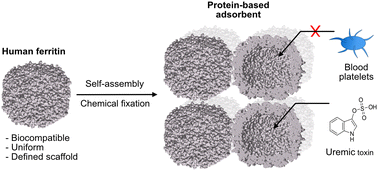
J. Mater. Chem. B, 2023,11, 55-60
https://doi.org/10.1039/D2TB02386E
Spatiotemporal control over 3D protein nanocage superlattices for the hierarchical encapsulation and release of different cargo molecules
Three-dimensional ferritin nanocage superlattices can serve as a two-compartment system for the hierarchical encapsulation and release of two different cargoes in a spatiotemporally controlled manner.

J. Mater. Chem. B, 2022,10, 9968-9973
https://doi.org/10.1039/D2TB01961B
Hierarchical peroxiredoxin assembly through orthogonal pH-response and electrostatic interactions
Highly ordered anisotropic assemblies of toroidal peroxiredoxin protein cage are reported by the sequential and orthogonal input of pH and chemical stimuli.

J. Mater. Chem. B, 2023,11, 11544-11551
https://doi.org/10.1039/D3TB00369H
Construction of viral protein-based hybrid nanomaterials mediated by a macromolecular glue
A dopamine based macromolecular glue is used to facilitate the construction of hybrid nanomaterials that are coated with virus capsid proteins, with the aim to improve stability, biocompatibility, and function.
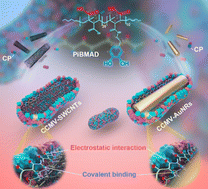
J. Mater. Chem. B, 2023,11, 7933-7941
https://doi.org/10.1039/D2TB02688K
Rational design of elastin-like polypeptide fusion proteins to tune self-assembly and properties of protein vesicles
Protein vesicle self-assembly and size can be tuned by manipulating the amino acid sequence and length of elastin like polypeptide.

J. Mater. Chem. B, 2023,11, 6443-6452
https://doi.org/10.1039/D3TB00200D
Engineering the HK97 virus-like particle as a nanoplatform for biotechnology applications
The research described here looks at the development of virus-like particles (VLPs) derived from bacteriophage HK97 as versatile scaffolds for bionanomaterials construction.

J. Mater. Chem. B, 2023,11, 6060-6074
https://doi.org/10.1039/D3TB00318C
An artificial viral capsid decorated with a DNA aptamer internalizing into lymphoma cells
Tumor-specific drug-delivering nanocarriers could be a promising modality for next-generation tumor therapy.
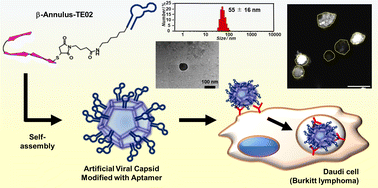
J. Mater. Chem. B, 2023,11, 6053-6059
https://doi.org/10.1039/D3TB00169E
Self-assembly of a fluorescent virus-like particle for imaging in tissues with high autofluorescence
Qβ VLP simplified assembly approach uses the positively charged Rev tag to interact electrostatically with the negatively charged RNAs. This system exploits the known hairpins produced in the coat protein sequence to template the assembly of the full viral capsid.

J. Mater. Chem. B, 2023,11, 4445-4452
https://doi.org/10.1039/D3TB00469D
Enzyme/inorganic nanoparticle dual-loaded animal protein/plant protein composite nanospheres and their synergistic effect in cancer therapy
Glucose oxidase and Fe3O4 nanoparticles were successfully loaded inside regenerated silk fibroin/zein nanospheres to obtain composite nanospheres, which have significant potential for combining starvation and chemodynamic therapy.

J. Mater. Chem. B, 2023,11, 4529-4538
https://doi.org/10.1039/D3TB00402C
Highly modular hepatitis B virus-like nanocarriers for therapeutic protein encapsulation and targeted delivery to triple negative breast cancer cells
A modular hepatitis B virus-like particle delivery platform enables enhanced uptake and toxicity in cancer cells.
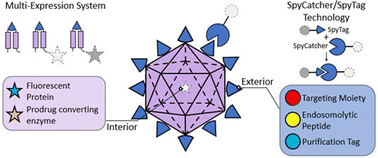
J. Mater. Chem. B, 2023,11, 3985-3993
https://doi.org/10.1039/D3TB00445G
Synthetic engineering of a new biocatalyst encapsulating [NiFe]-hydrogenases for enhanced hydrogen production
By incorporating [NiFe]-hydrogenases into a proteinaceous carboxysome shell, we generate a novel biocatalyst that has improved production of clean hydrogen, oxygen tolerance, and thermostability, highlighting its great potential in biotechnological applications.
![Graphical abstract: Synthetic engineering of a new biocatalyst encapsulating [NiFe]-hydrogenases for enhanced hydrogen production](/en/Image/Get?imageInfo.ImageType=GA&imageInfo.ImageIdentifier.ManuscriptID=D2TB02781J&imageInfo.ImageIdentifier.Year=2023)
J. Mater. Chem. B, 2023,11, 2684-2692
https://doi.org/10.1039/D2TB02781J
Sequential administration of virus-like particle-based nanomedicine to elicit enhanced tumor chemotherapy
Immunological problems have prevented applications of Virus like particles (VLPs). Here, we show that using immune-orthogonal VLPs sequentially and modifying of major immune region can circumvent immune responses after repeated administration.

J. Mater. Chem. B, 2023,11, 2674-2683
https://doi.org/10.1039/D2TB02163C
Pt(II) metallacycles encapsulated by ferritin enable precise cancer combination chemo-photodynamic therapy
We developed a multi-therapeutic organoplatinum-based drug (HFn-PtM) with good water solubility and active targeting via capturing metallacycles into the cavity of human heavy chain ferritin nanocages, which exhibited excellent anti-tumor efficiency.

J. Mater. Chem. B, 2023,11, 1090-1099
https://doi.org/10.1039/D2TB02349K
microRNA-181a silencing by antisense oligonucleotides delivered by virus-like particles
Encapsulation of anti-miR-181a oligonucleotide into plant virus cowpea chlorotic mottle virus (CCMV) improves the stability of both RNA oligonucleotides. Knockdown efficacy was significantly improved with CCMV encapsulation compared to non-encapsulated counterpart.
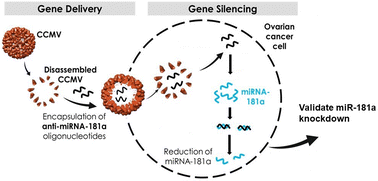
J. Mater. Chem. B, 2023,11, 816-825
https://doi.org/10.1039/D2TB02199D
About this collection
Protein cages are highly ordered macromolecules that can be genetically encoded and chemically modified. They are characterized by well-defined structures, controllable self-assembly, capacity for cargo loading, and facile chemical or genetic engineering. Protein cages hold great potential as versatile platforms in diverse fields. Applications include biomedicine and drug delivery; enzymology and biocatalysis; bioinspired materials and templates for inorganic chemistry. These applications are underpinned by fundamental science drawing on the fields of biological chemistry, biophysics, physical chemistry, and computational chemistry. This themed collection in Journal of Materials Chemistry B is Guest Edited by Prof. Jeroen Cornelissen (University of Twente, the Netherlands), Prof. Feng Li (Wuhan Institute of Virology, China) and Dr Frank Sainsbury (Griffith University, Australia) and aims at providing a platform for recent developments in this rapidly evolving field of protein cages including, de novo design, biophysics of self-assembly, permeability, biocatalytic nanoreactors, artificial organelles, delivery of bioactive molecules, bioimaging and biosensing, multifunctional nanodevices and other applications. We hope that readers find this themed collection informative and that it will act as an up-to-date insight into the fascinating potential of protein cages in chemistry.